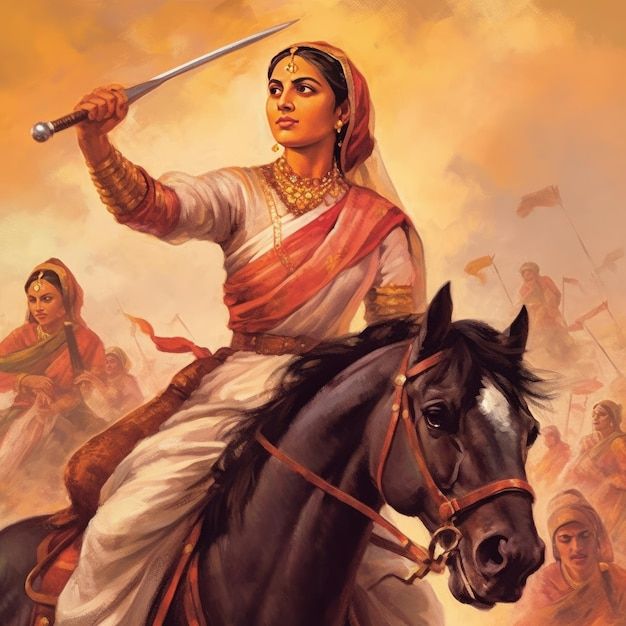Rani Lakshmi Bai: 10 Powerful Lessons from the Life of the Queen of Jhansi
Rani Lakshmi Bai, the Queen of Jhansi, is one of the most revered and iconic figures in Indian history. Known for her bravery, resilience, and undying commitment to the independence of India, she became a symbol of resistance during the First War of Indian Independence in 1857. Her courage and leadership have made her a hero in Indian history, and she remains a powerful inspiration for generations. Let’s take a closer look at the life of this remarkable woman, her legacy, and her enduring impact on Indian society.
Early Life of Rani Lakshmi Bai
Rani Lakshmi Bai was born as Manikarnika Tambe on November 19, 1828, in Varanasi, India. She was the daughter of Moropant Tambe, a Brahmin official in the Maratha Empire, and Bhagirathi Bai. From a young age, Manikarnika, or Manu as she was called, displayed a keen interest in learning and physical activities. Her father encouraged her to study the arts of warfare, horsemanship, and archery, which were unusual pursuits for girls of that time.
In 1842, at the age of 14, Manikarnika married the Maharaja of Jhansi, Raja Gangadhar Rao, and was given the name Lakshmi Bai. The couple did not have children of their own, and after the death of the Maharaja in 1853, the British East India Company refused to recognize her adopted son as the heir to the throne, citing the controversial Doctrine of Lapse. This decision played a significant role in the uprising that followed.
Rani Lakshmi Bai’s Role in the 1857 Rebellion
Rani Lakshmi Bai is best known for her leadership during the Indian Rebellion of 1857, often referred to as the First War of Indian Independence. When the British East India Company tried to annex Jhansi through their Doctrine of Lapse, Rani Lakshmi Bai refused to accept the British rule over her kingdom. She courageously took a stand and rallied her forces to protect her state.
In 1857, when the rebellion began, Rani Lakshmi Bai led her army with valor, engaging in fierce battles against the British. She personally led the charge in defending her kingdom, despite the overwhelming British forces. Known for her skill in combat and strategy, she was often seen riding into battle on horseback, armed with a sword and a gun. Her leadership and bravery in battle earned her the admiration of both her supporters and enemies alike.
In one of the most iconic episodes of the rebellion, Rani Lakshmi Bai was forced to leave Jhansi after the British laid siege to the fort. But even then, she did not give up the fight. She fled to Gwalior, where she continued to fight until her death on June 18, 1858, in a battle near Gwalior. Her death marked the end of the rebellion, but her legacy lived on.
Key Facts About Rani Lakshmi Bai
- Unmatched Courage: Rani Lakshmi Bai is remembered for her unparalleled courage and determination in the face of adversity. Her refusal to surrender Jhansi to the British forces during the siege of the fort made her a national hero.
- Warrior Queen: Not only did Rani Lakshmi Bai rule her kingdom with wisdom and care, but she also led her army into battle. She was a skilled horsewoman and an expert in sword fighting, making her a formidable leader on the battlefield.
- Symbol of Resistance: Lakshmi Bai became a symbol of resistance against British colonial rule. Her leadership inspired many others to rise against British oppression during the 1857 rebellion, and she remains a symbol of India’s fight for independence.
- Adopted Son and Doctrine of Lapse: The British East India Company’s refusal to recognize her adopted son, Damodar Rao, as the legitimate heir to the throne of Jhansi was one of the key factors that fueled the rebellion in Jhansi. Lakshmi Bai’s adoption of her son was in accordance with Indian customs, but the British sought to annex Jhansi using the Doctrine of Lapse, which led to conflict.
- Legacy of Leadership: Rani Lakshmi Bai’s leadership was not only about military prowess. She was also known for her wisdom and administrative skills. She worked tirelessly to ensure the welfare of her people and protect her kingdom from foreign domination.
- Symbol of Women’s Empowerment: In an era where women were often relegated to traditional roles, Rani Lakshmi Bai’s role as a leader and warrior stood out. She is considered a trailblazer in terms of women’s empowerment, and her story continues to inspire countless women to take leadership roles in society.
- Recognition in History: Rani Lakshmi Bai has been immortalized in Indian history through literature, films, and documentaries. Her name is synonymous with courage, sacrifice, and the fight for justice.
Daily Life and Impact
Rani Lakshmi Bai’s daily life was marked by her deep commitment to her people and her kingdom. As queen, she was involved in the administration of her state, making sure that her subjects were treated fairly and that justice prevailed. She was known to be a kind and compassionate ruler, with a focus on the welfare of her people.
Her military skills were developed through constant practice and training. She maintained a rigorous schedule, balancing her duties as a ruler with her responsibilities as a warrior. She was often seen riding on horseback, practicing archery, and strategizing with her military commanders. Despite the constant threat of British forces, she remained steadfast in her commitment to protect her kingdom.
FAQs
Q: What made Rani Lakshmi Bai a great leader?
A: Rani Lakshmi Bai was a great leader because of her unmatched courage, strategic mind, and dedication to her people. She did not only fight for her kingdom but also inspired others to rise against the British. Her leadership qualities, both as a ruler and a warrior, earned her a place in history as one of India’s greatest leaders.
Q: How did Rani Lakshmi Bai die?
A: Rani Lakshmi Bai died on June 18, 1858, in a battle near Gwalior. Despite the overwhelming British forces, she fought bravely until her death, which marked a significant point in the rebellion.
Q: Why is Rani Lakshmi Bai considered a symbol of women’s empowerment?
A: Rani Lakshmi Bai is considered a symbol of women’s empowerment because of her leadership in a male-dominated society. She broke societal norms by being a queen who was not just an administrator but also a warrior. Her story continues to inspire women to take on roles of leadership and courage.
Q: What was Rani Lakshmi Bai’s role in the 1857 rebellion?
A: Rani Lakshmi Bai played a central role in the 1857 rebellion as the leader of the resistance in Jhansi. She fought against British forces with great courage and tactical acumen, and her actions made her a symbol of India’s resistance against colonial rule.
Significance and Observance
Rani Lakshmi Bai is not just a historical figure; she is a national symbol. Her life represents the spirit of independence, the strength to fight for one’s rights, and the courage to stand against oppression. Every year, her bravery and leadership are celebrated, and she is honored through memorials, schools, and films. Her legacy continues to inspire individuals, especially women, to pursue their dreams and fight for justice.
Rani Lakshmi Bai’s life was one of sacrifice, strength, and relentless determination. Her courage in the face of danger, her leadership in battle, and her tireless fight for the independence of her people have made her one of the most iconic figures in Indian history. She remains an inspiration, a symbol of resilience, and an epitome of true leadership.










